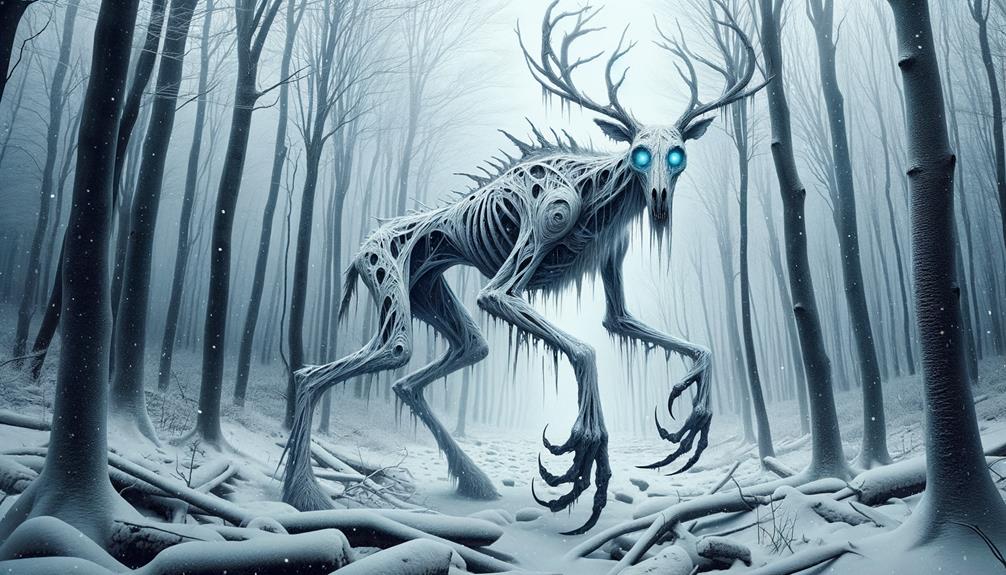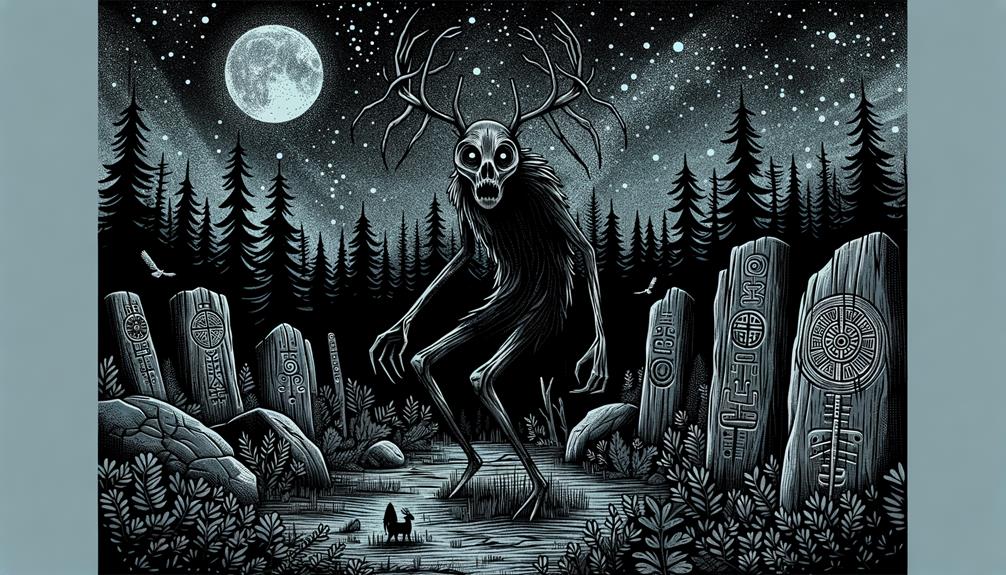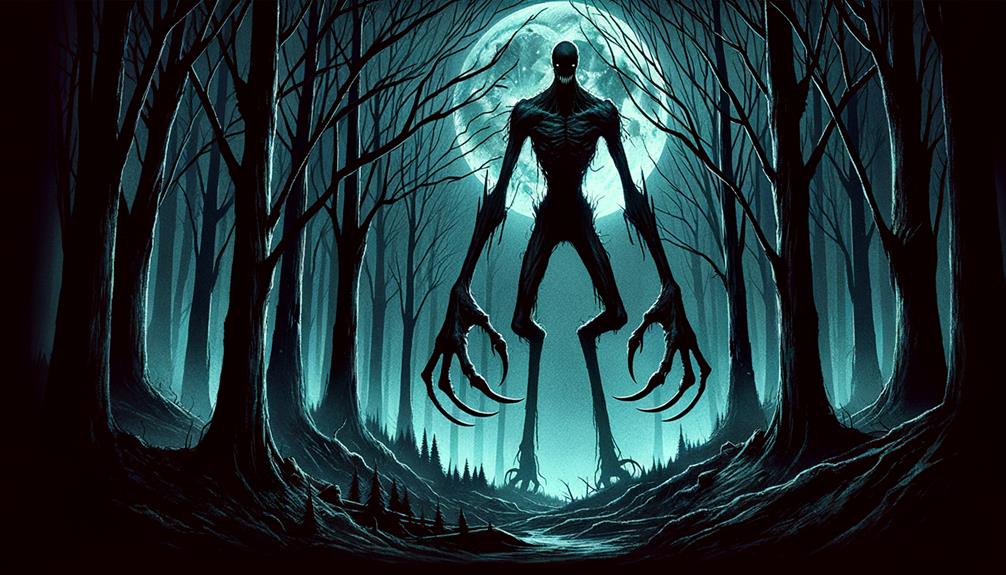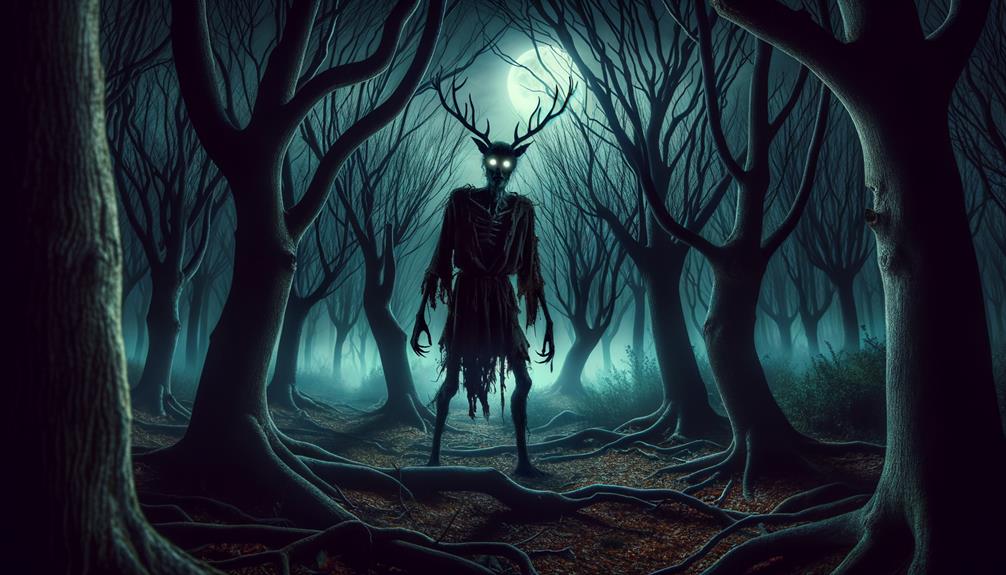Unraveling the Tale of the Wendigo: An Algonquian Nightmare
Immerse yourself in the chilling lore of the Wendigo, an infamous entity from Algonquian folklore. This creature, often depicted as a malevolent spirit with unsettling human characteristics, has a sinister reputation for its insatiable craving for human flesh. Yet, the Wendigo is much more than just a fearsome beast. It's an ominous harbinger of winter, an emblem of starvation, and a chilling reminder of the taboo act of cannibalism.
Diving Deeper into the Wendigo Mythology
Modern-day adaptations in literature, film, and television have significantly expanded the Wendigo's cultural impact. It's often employed metaphorically to represent the unchecked greed and the shadowy facets of human nature. However, as we dissect the legend of the Wendigo, we might uncover aspects of this creature that are more intricate and potentially more pertinent to our current society than we'd initially think.
Unmasking the Wendigo: More than a Monster
The Wendigo is not just a monster from old tales designed to keep children awake at night. Instead, it's a symbol of a more profound societal conundrum. The Wendigo's insatiable hunger is a metaphor for human greed and excess, a theme increasingly relevant in our resource-strained world. As we delve into the story of the Wendigo, we don't just uncover a monster; we reveal a mirror to our own darker tendencies.
The Wendigo's Echo in Modern Society
The legend of the Wendigo is not just a relic of the past, but a poignant commentary on our contemporary society. Its insatiable hunger serves as an allegory for unchecked ambition, while its association with winter and famine reminds us of our environmental responsibilities. This makes the Wendigo more relevant today than we might want to admit.
Conclusion: The Wendigo – A Reflection of Human Nature
In conclusion, the Wendigo from Algonquian folklore is more than an evil spirit meant to scare. It's a metaphor for human nature's darker side, a symbol of unchecked greed, and a reminder of our environmental responsibilities. Its relevance in our modern society is profound and thought-provoking, serving as a brutal reminder of the potential consequences of uncontrolled avarice and disregard for our environment.
So, the next time you hear the chilling tale of the Wendigo, remember, it's not just a monster. It's a stark reflection of the darker aspects of our own humanity.
Origins of the Wendigo Myth

Unearthing the Wendigo Myth: A Deep-Dive into its Roots
The Wendigo myth, steeped in the rich tapestry of Algonquian cultures, originates from the northeastern regions of North America. This chilling tale forms a significant thread in the fabric of Native American narratives. The indigenous people, speakers of the Algonquian language, have often regaled their kin with stories of the Wendigo – an evil spirit that exemplifies greed, excess, and selfishness.
The Wendigo: An Embodiment of Terror and Morality
This monstrous entity is infamous for its cannibalistic tendencies. It's said to possess humans, driving them to commit heinous acts of violence and cannibalism. However, the Wendigo myth isn't merely a horror story designed to send shivers down one's spine. It serves a higher purpose within the indigenous cultures, one that influences their values and belief systems significantly.
The Wendigo Myth: A Social Tool for Community Bonding
The murky origins of the Wendigo myth suggest it was likely conceived as a social tool, aimed at promoting communal harmony. By evoking fear of turning into a Wendigo, the myth encourages the adherence to social norms and discourages selfish behavior within tribal communities. It's a potent reminder of the importance of unity, sharing, and mutual respect among tribe members. The emphasis on community over individualism is a pillar of many Native American cultures.
The Wendigo: More than Just a Bedtime Story
In essence, the Wendigo myth transcends the realm of simple folklore, serving as a cultural preservation tool and a beacon for moral guidance. As we delve deeper into the origins of the Wendigo myth, we can appreciate its prominence in the wider context of indigenous cultural narratives. It's not only a spine-tingling tale but also a significant part of the cultural heritage and moral compass of Native American communities.
In Conclusion
Understanding the Wendigo myth gives us a glimpse into the rich cultural narratives of the Algonquian cultures. These narratives continue to influence the values and belief systems of their descendants to this day. They are more than just chilling tales; they are living, breathing embodiments of a culture that values community and mutual respect above all else.
Physical Description and Characteristics

Diving Into The Intriguing World of Wendigo
Wendigo: A name that brings with it a chilling image of a creature embodying winter's harshness and the desperation of starvation. Often visualized as a towering, skeletal figure, the Wendigo's unique physical attributes create an eerie yet captivating image. Here are the four key characteristics that make this creature stand out:
1. Gaunt to the Extreme****: The Wendigo is more than just thin – it's emaciated. Its skin, dry and stretched over its bones, makes it appear as if it's just been unearthed from a grave. This skeletal look is not merely for show; it symbolizes the Wendigo's insatiable hunger. It's a striking metaphor that drives home the extremity of this creature's evil nature.
2. Eyes that Haunt****: Nestled deep within their sockets, the Wendigo's eyes glow with an unsettling light. This spectral glow casts an eerie aura further enhancing the creature's chilling presence.
3. Adept Hunter with Deadly Claws****: Despite the deep snow, the Wendigo navigates with ease, its long arms ending in sharp, yellowed claws. These claws, often blood-stained from recent kills, are a testament to the Wendigo's hunting prowess.
4. Strength and Agility****: Don't be fooled by its skeletal appearance. The Wendigo's frail form belies a surprising strength and agility, adding an unexpected and terrifying element to its image.
By combining these features, we get a powerful representation of a creature that not only embodies the harshness of winter and the desperation of starvation, but also resonates with the number 107 in Algonquian numerology, symbolizing the extremity of its evil nature.
In Conclusion
The Wendigo is a fascinating creature, its distinctive physical characteristics painting a vivid and chilling image. From its emaciated form to its glowing eyes, every aspect of this creature is designed to inspire fear and awe. It's a testament to the power of mythology and storytelling, a symbol of the harshness of nature and the desperation of hunger. As you delve deeper into the world of Wendigo, you'll find yourself captivated by its unique blend of horror and intrigue.
Wendigo in Algonquian Culture

Wendigo: A Symbol of Power, Fear, and Caution in Algonquian Culture
Welcome to a deep dive into the world of the Wendigo, a critical figure in Algonquian culture. This malevolent spirit is not merely a horrific figure; it serves as a potent symbol reflecting the values, challenges, and traditions of indigenous North American tribes, such as the Algonquian, Ojibwe, and others.
A Glimpse into Wendigo's Chilling Physical Characteristics
The Wendigo is more than a creature of nightmares. Its chilling physical features represent the harsh realities of life in North America's winter landscapes. Known for its insatiable hunger and association with cannibalism, the Wendigo encapsulates the scarcity and struggle that often mark the harsh winter months among the First Nations tribes.
Wendigo: A Cautionary Tale Against Greed and Selfishness
The Wendigo's insatiable hunger symbolizes more than physical need; it is a stark reminder of the dangers of greed and excess. Reflecting the core values of Algonquian culture, it serves as a warning against abandoning cultural norms and traditions. The Ojibwe scholar Basil Johnston views the Wendigo as a potent symbol of selfishness and excess, urging us to learn from it and avoid such behaviors.
Understanding Wendigo Psychosis: A Cultural Syndrome
The concept of Wendigo psychosis, a subject of debate among scholars, adds another layer to the Wendigo's narrative. This cultural-bound syndrome affects indigenous communities, causing an intense craving for human flesh and a profound fear of becoming a Wendigo. It serves as a metaphor for the internal struggle against self-destructive behaviors.
Wendigo in Literature and Media: Keeping the Cultural Narrative Alive
The Wendigo's presence in literature and media is much more than sensationalism. It is a way to keep the cultural narrative alive and relevant, ensuring the continuation of these fascinating traditions.
Wendigo: More than a Mythical Creature
In conclusion, the Wendigo is not just a mythical creature; it is a powerful symbol of human struggle, caution against excess, and a reflection of indigenous North American values. Its tale, deeply ingrained in Algonquian culture, serves as a captivating reminder of the importance of maintaining balance and respect for cultural norms.
Contemporary Portrayals and Interpretations

The Modern Reinvention of the Wendigo: A Symbol of Human Excess
The Wendigo, a fascinating figure from Algonquian lore, has been given a fresh lease on life in contemporary media and literature. Its enduring and diverse portrayals often serve as a critique of the darker side of humanity, reflecting our tendencies towards excessive consumption, greed, and a lack of respect for the environment.
The Wendigo in Film and Television: A Terrifying Spectacle
The Wendigo has made its mark on the silver screen and in television series. Notable examples include Guillermo del Toro's cinematic masterpiece, 'Wendigo', and Scott Cooper's spine-chilling 'Antlers'. Both these films center their narratives around the Wendigo's monstrous form and insatiable hunger, creating an unforgettable visual and emotional experience for viewers.
The Subtle Influence of Wendigo in Literature: Stephen King's Pet Sematary
Stephen King's 'Pet Sematary' subtly incorporates the Wendigo, hinting at its sinister influence over the heartrending events of the novel. This portrayal brings the creature to life in the reader's imagination, adding another layer of depth to the chilling narrative.
Wendigo in Comic Books: The Wild Terror of Marvel's Universe
In the realm of comic books, Marvel's 'Wendigo' stands as a formidable antagonist. It embodies the raw spirit of the wilderness and the fear it can strike in the hearts of those who dare to cross its path.
The Wendigo in Video Games: A Chilling Encounter in 'Until Dawn' and 'Fallout 76'
The Wendigo has also found a home in the gaming world. In titles like 'Until Dawn' and 'Fallout 76', the Wendigo serves as a menacing adversary, providing players with a thrilling and spine-chilling gaming experience.
In each of these portrayals, the Wendigo is reborn, yet it remains rooted in its Algonquian origins. Its widespread presence in popular culture is a testament to our enduring fascination with the monstrous and our collective anxieties about our relationship with nature. These modern reinterpretations of the Wendigo serve as a compelling reminder of our responsibilities towards our environment and each other.
The Symbolism of Wendigo

Unmasking the Wendigo: A Profound Symbol of Human Excesses
Scratching beneath the surface of the fearsome Wendigo, we unearth a powerful emblem of unrestrained greed, relentless hunger, and the chilling aftermath of these human vices. The Wendigo, an Algonquian evil spirit, is more than just a monster. It's a cannibalistic beast that embodies the most destructive elements of human behavior.
Wendigo Monster: The Dark Side of Human Nature
The Wendigo Monster is frequently viewed as an embodiment of Wendigo psychosis. This term is used to describe a situation where an individual is convinced they're taken over by a Wendigo. This possession mirrors how greed and an intense survival instinct can overpower our human nature, pushing us to behave like monsters.
Wendigo Symbolism: A Reflection of Society and Economy
The symbolism of Wendigo extends beyond individual behavior to societal and economic critique. The concept of 'Wendigo economics' represents an economic system driven by an insatiable appetite for growth and profit, oblivious to its destructive consequences. This mirrors the Wendigo's perpetual hunger, which can never be quenched.
The Wendigo: A Cautionary Tale
In essence, the Wendigo acts as a warning, cautioning us about the repercussions of unrestrained desires and excesses. It serves as a stark reminder that even as humans, we can morph into monsters when our greed and thirst for power or survival overshadow our humanity.
By embracing the lessons from the Wendigo's symbolism, we can strive to keep our desires in balance, ensuring they don't eclipse our human nature. This can guide us towards a more sustainable and empathetic approach to life, preserving not just our humanity, but also our world.
Remember, the Wendigo is not just a monster from folklore. It's a symbol that carries a timeless message about the destructive potential of unchecked human desires. It's a call to action, urging us to be mindful of our actions and their consequences, and to live in harmony with ourselves and nature.
Final Thoughts: Embrace Balance, Avoid the Wendigo
Frequently Asked Questions
What Is the Algonquian Word for Evil Spirit?
Understanding the Algonquian Concept of Evil Spirits
In the rich tapestry of Algonquian culture, one term stands out due to its compelling complexity: 'Wendigo.' This term, deeply woven into their folklore, denotes an evil spirit. Yet, it's much more than a typical representation of malevolent forces. The term Wendigo symbolizes the dire consequences of uncontrolled human desires and excessive greed.
Why 'Wendigo' is More Than Just an Evil Spirit
The Algonquian term 'Wendigo' is not just a simple translation for 'evil spirit.' It's an embodiment of the societal repercussions of unrestrained human desires, depicting the horrific outcome of such traits. When we examine this term, we don't just see a malicious entity. Instead, we see a cautionary tale about the potential pitfalls of human nature.
Unpacking the Symbolism of 'Wendigo'
In Algonquian folklore, Wendigo serves as an example. It's a reminder to keep our desires in check, to avoid falling into the abyss of greed. This real-world example from their culture provides a fascinating insight into their values and beliefs.
The Relevance of 'Wendigo' Today
The term Wendigo, though rooted in ancient Algonquian culture, continues to resonate today. It's a timeless reminder of the dangers of unchecked greed and desires, a concept that remains highly relevant in our modern world.
What Is a Wendigo of Algonquian Mythology?
Understanding the Wendigo: A Glimpse into Algonquian Mythology
In the captivating world of Algonquian mythology, the Wendigo stands out as a fascinating, albeit eerie, figure. This malevolent spirit is often associated with an insatiable appetite and a terrifying tendency towards cannibalism. The Wendigo is more than just a spine-chilling mythical creature – it serves as a powerful symbol of the perils of unchecked desires and overwhelming greed, especially during periods of scarcity.
The Unsettling Nature of the Wendigo
Diving deeper into the lore, the Wendigo is not just a random, malicious entity. Its association with excessive hunger and cannibalistic tendencies paints a vivid picture of the dangers of unchecked desires. This becomes particularly salient in times of scarcity when resources are limited and survival instincts take over. The Wendigo thus serves as a stark reminder of the destructive potential of greed.
Real-World Implications of the Wendigo Myth
The Wendigo is not just a figure of terror in Algonquian mythology. It holds real-world implications and lessons. For instance, in the context of environmental conservation, the Wendigo can be seen as a symbol of reckless consumption that leads to resource depletion. As such, the myth can serve to raise awareness about sustainable practices and the need to curb our insatiable appetites.
The Wendigo: A Symbol of Caution
In conclusion, the Wendigo from Algonquian mythology offers a deep insight into human nature and our potential for destructive greed. By understanding this myth, we can better navigate our desires and avoid the metaphorical transformation into a Wendigo. After all, as the saying goes, "We are what we consume." So let's strive to consume wisely and sustainably, embracing the lessons this ancient myth provides.
What Is the Wendigo the Spirit Of?
The Fascinating Spirit of the Wendigo: An Algonquian Tale
Immerse yourself in the intriguing world of Algonquian folklore, where the Wendigo symbolizes an endless craving and the terrifying compulsion to devour human flesh. This is not merely a spooky story. The Wendigo serves as a powerful metaphor for uncontrolled avarice and the shadowy aspects hidden within us all.
Understanding the Wendigo: A Spirit of Insatiable Hunger
In the riveting narratives spun by Algonquian storytellers, the Wendigo takes form as a voracious entity driven by an unquenchable hunger. This creature is not just a mythical beast, but a chilling representation of unchecked greed.
Dark Potential: The Human Element in the Wendigo Myth
The Wendigo also reflects the darker side of human nature, a side that we often prefer to ignore. It offers a stark reminder of what can occur when our baser instincts are left unchecked.
A Lesson from the Wendigo: The Consequences of Unchecked Greed
Drawing on the Wendigo folklore, we're reminded that unchecked greed can lead to destructive behaviors. Just as the Wendigo is driven by an insatiable hunger for human flesh, unchecked greed can lead individuals down a dangerous path of self-destruction.
Embrace the Message, Not the Fear
While the Wendigo is a terrifying figure in Algonquian folklore, its story serves as a powerful cautionary tale. It's a narrative that encourages us to remain vigilant of our darker impulses, and to keep our personal desires in check. This way, we can avoid becoming consumed by our own unchecked greed, much like the dreaded Wendigo.
What Tribes Believe in the Wendigo?
The Intriguing Belief Systems of Algonquin-Speaking Tribes: A Deep-Dive into Wendigo Lore
After conducting extensive research, it becomes clear that the concept of the Wendigo, a malevolent spirit synonymous with insatiable hunger and the harsh ramifications of greed, is deeply entrenched in several Algonquin-speaking tribes. The Ojibwe, Cree, and Innu tribes, in particular, have proven to be firm believers in the existence of this entity.
Let's look at these tribes more closely. The Ojibwe, for instance, hold steadfast to the belief in Wendigo, viewing it as a warning against the dangers of excessive greed. Similarly, the Cree and Innu tribes also uphold this belief, often using Wendigo tales as cautionary parables against uncontrolled desires and gluttony.
Diving Deeper into Wendigo Belief
The Wendigo is not just a figment of folklore; it represents a tangible element of the Algonquin-speaking tribes' belief system. Its significance cannot be understated. The Wendigo serves as a powerful reminder of the perilous consequences of greed and overconsumption, thereby promoting balance, moderation, and respect for the natural world.
To truly understand the impact of the Wendigo in these tribes' cultures, imagine being told tales of this fearsome spirit from a young age. These stories, full of vivid and chilling details, would undoubtedly instill a sense of caution and respect for the consequences of unchecked desires.
The belief in Wendigo is more than just a cultural artifact; it's an integral part of a broader belief system that guides and shapes the cultural norms and behaviors of these tribes. It's an embodiment of the potential dangers of unchecked greed, a stark reminder to always practice restraint and maintain a balanced approach to life's desires.
The Ultimate Takeaway
The Wendigo serves as a potent symbol, a reminder of the consequences of unchecked greed and the importance of balance and moderation. Its tales continue to resonate with the Ojibwe, Cree, and Innu tribes, offering a fascinating glimpse into their rich cultural tapestry. This study of Wendigo beliefs provides an invaluable insight into the intricate belief systems of these Algonquin-speaking tribes, which is not just engaging and enlightening but also serves as a testament to the richness and diversity of indigenous cultures.

